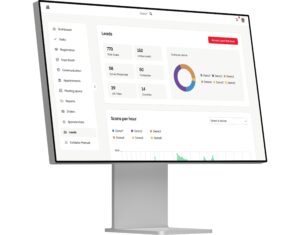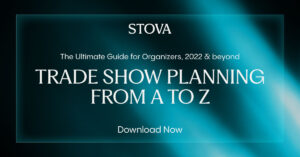3 Steps to Proving the Value of Trade Show Marketing
June 8, 2023
Trade shows provide opportunities to showcase your products, drive leads and sales, and stay up to date on industry innovations. Historically, trade shows and other in-person events have taken up the biggest piece of the B2B marketing budget. However, according to research by Forrester, only 18% of event technology providers say their clients can measure their return on investment (ROI). Surely, we can do better than that!
The good news: Technology is available to lend a hand.
This article provides a 3-step blueprint for measuring the value of your trade show marketing. You’ll also find surefire tips and tools to elevate attendee satisfaction.
What is trade show ROI?
ROI shows the value your company gets from participating in a show for the cost.
Costs include registration fees; travel; hotels; booth rental, design, and transportation; staffing; and marketing collateral.
Value comes from direct sales, contracts, leads, referrals, brand exposure, and more.
Why is measuring ROI critical now?
Virtual events showed the importance of tracking attendee behavior and demonstrating value. Now that live trade shows have returned, senior leadership expects to see the ROI of this channel, too. We know in-person B2B attendees are in decision-making mode. They take time from their hectic schedules to attend and gain insights that inform their buying decisions.
Event measurement quantifies the value of these interactions and helps you prioritize your investment and improve outcomes.
So, how do you calculate trade show marketing value?
The most straightforward formula is:
ROI = (Net Profit / Total Cost) x 100
Suppose you spent $5,000 to participate in a show and earned $25,000 in revenue.
Total Cost = $5,000
Net Profit = Revenue – Cost
$25,000 – $5,000 = $20,000
ROI = ($20,000 / $5,000) x 100 = $400%
The event generated a return four times the initial investment.
Overcome hurdles.
This formula works fine for revenue goals, but tracking other outcomes gets more challenging.
For example, how do you measure gains in brand awareness or customer satisfaction? How do you track deals originating at the show but closing months afterward?
The answer: To show the value of your trade show marketing strategy with less tangible goals, follow this three-step blueprint.
Step 1: Identify your primary goal and KPIs.
First, determine the main reason you’re participating in the show. Is it to launch a new product? Increase sales? Educate customers and prospects?
Make a list of all your potential event goals. Then drill down to the most important one.
Let this goal serve as your guide to help define content, booth design, activations, outreach, and technology choices.
Create key performance indicators (KPIs) to support your goal.
A KPI is a “measure of performance over time for a specific objective. KPIs provide targets for teams to shoot for… and insights that help people across the organization make better decisions.”
To this end, effective KPIs are specific, measurable, and actionable.
For example, how many quality prospects will you add to your database? How much pipeline will the team generate?
Pro Tips:
- Keep it simple. Having too many trade show goals dilutes your resources and reduces your ability to achieve your main goal.
- Measure what matters. Think about what would bring joy to the heart of your CEO: Knowing that 72 percent of attendees chose chicken for dinner? Or increasing attendee purchase intent by 19 percent? Getting the details right is essential for flawless execution. But when measuring the value of trade show marketing, focus on the outcome that matters most.
- Set realistic goals. Companies are more deliberate about travel spending in this economy, often leading to lower event attendance.
But on the upside, shows now attract more senior-level executives with buying power.
When setting goals, concentrate less on volume, like the number of visitors to your booth. New ROI metrics emphasize quality, such as the level of engagement with target accounts and the progression of deals through the pipeline.
Step 2: Collect data.
Innovative virtual and onsite solutions pump up attendee engagement and capture a goldmine of ROI data. By connecting the dots, you can gain deep customer insights from tools like these below:
- QR and NFC badges power contactless lead retrieval. They also work with event check in apps and facial recognition kiosks to elevate the arrival experience. Use digital badging for fast, convenient contact info exchange, access control, cashless payments, and more. As another significant benefit, the paperless badges reduce the environmental impact of your event.
- Attendee tracking and beacon technology for events help personalize the journey.
- Want to quantify success throughout the event lifecycle? The best mobile event apps power each corner of the show. This includes everything from streamlined event registration to personalized agendas, networking, on-demand session library, and more.
- Event apps also drive lead retrieval. These solutions empower exhibitors to use one tool for lead scanning, tracking, ranking, content sharing, networking, and more. Sync leads with your Customer Relationship Management (CRM) system for customized follow-up. With everything in one place, tap ‘n go lead retrieval makes it easier to engage with the contacts that matter most.
- Like Netflix for trade shows, exhibitor-to-attendee matchmaking uses artificial intelligence to recommend opportunities based on past behavior. A great way to improve networking and make the most of your time at the show!
- Research shows gamification skyrockets engagement. Drive booth traffic and uplevel exposure by showcasing your brand on immersive games, quizzes, and challenges.
- Provide proof of trade show marketing value with event analytics and ROI reports. They can highlight metrics for lead quality, sponsored session ratings, content downloads, net promoter score, and more. You’ll get a deeper understanding of attendee preferences and place in the buyer’s journey.
Keep your eye on the goal.
It’s clear you have a wealth of options for delighting attendees with memorable experiences that can inform buying decisions. But avoid investing in event technology for technology’s sake.
Choose tools that tie data capture and measurement to your trade show marketing goal.
Take this example below:
Goal: Generate quality leads
What You Can Measure:
- Number of prospects and accounts the show adds to your database
- Quality of connections as shown by relevance, seniority, and potential for collaboration
- Place in the buyer’s journey, indicated by session selection and content downloads
- Level of interaction with booth demos and activations
- Engagement, dwell time, and questions asked during sponsored sessions
- And more
Sample Data Collection & Measurement Tools: Lead retrieval app, digital badging, mobile app for events, event check in app, CRM systems, event analytics, and ROI reporting software.
Step 3: Get the full ROI story.
Measuring trade show ROI gets complicated when you patch together single-point solutions that don’t talk to each other. The problem? Data goes missing, and you get an incomplete ROI picture.
By contrast, all-in-one event management technology consolidates real-time data automatically. This includes onsite and digital activities throughout the event lifecycle. Graphics show at-a-glance the value trade show marketing delivers.
Result: All the event intelligence you need is at your fingertips, ready to pull up at a moment’s notice. You gain valuable attendee insights and a comprehensive picture of trade show ROI.
What about deals that originate onsite but close afterward?
Technology provides an easy fix:
Merge event data with your CRM and marketing automation systems. Then you can track buyer behavior for weeks, months, or even years post-event.
You’ll capture the buyer’s journey over the long term. And show with hard data how your trade show contributes to the company’s bottom line.
Optimize performance.
So now you know how to prove trade show ROI, but there’s still important work to do.
Follow up with leads right after or during the show. Take advantage of fresh attendee insights to customize value-added offerings. With post-event measurement and follow-up done, it’s time to start thinking about the next show. But you’ll improve your marketing strategy by leaps and bounds. Because you’ll draw on new data that shows exactly what tactics worked great and what needs improvement.
Use this intel to refine your approach for even more impressive successes to come.
Wrapping up
Ready to level up your trade show marketing, lift customer satisfaction, and contribute even more to your company’s growth?
Whether your event is virtual, hybrid, or in-person, enhance your attendee’s journey with an event ecosystem built for your audience. Ready to walk through Stova's event technology solutions? Schedule some time with us today.





